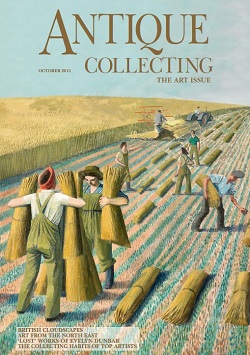Antique Collecting – October editorial
 The October issue of Antique Collecting has a leaning towards ‘art’, with a broad interpretation of what is covered by the word. At one time it was clear that art was mainly concerned with painting, sculpture and architectural production resulting from human skills. But the development of technology brought new relationships with art as much as any other activity.
The October issue of Antique Collecting has a leaning towards ‘art’, with a broad interpretation of what is covered by the word. At one time it was clear that art was mainly concerned with painting, sculpture and architectural production resulting from human skills. But the development of technology brought new relationships with art as much as any other activity.
 In his article on the history of photography in this issue, John Wade reminds the reader that when Louis Daguerre produced his first photos in 1839, legend has it that the artist Paul Delaroche exclaimed that ‘from today, painting is dead!’ One supposes that it was thought that art was representational, so the more accurate daguerreotype would take over its role. It turned out that with photography to do that, art could wander off into many other visual highways and byways until, at a point not so long ago, abstract art was almost de rigeur.
In his article on the history of photography in this issue, John Wade reminds the reader that when Louis Daguerre produced his first photos in 1839, legend has it that the artist Paul Delaroche exclaimed that ‘from today, painting is dead!’ One supposes that it was thought that art was representational, so the more accurate daguerreotype would take over its role. It turned out that with photography to do that, art could wander off into many other visual highways and byways until, at a point not so long ago, abstract art was almost de rigeur.
The fact that the new technology – photography – did not entirely take over the function of art and indeed developed an art role entirely of its own is another instance of technology mistakenly thinking it had supplanted existing practices rather than adding to them.
I was reminded of this when reading recently that American dealers are withdrawing from expensive shows and exhibitions in order to put more resources into their online presences.
Their forecast is that customers will use new technology to do their shopping online. Rather than fairs, the dealers want to spend more on presentations designed for small mobile equipment. It is easier, the theory goes, to use mobile phones or tablets than to sit at a desk top computer or TV set, or to go round locations such as shops and fairs.
Portable access to media makes for greater convenience. You can now carry, all in one pocket device, a computer, camera, telephone, TV, calculator, and possibly other Internet functions, which enable you to buy, sell, inspect, record and research any artwork or antique that you fancy.
It can be quite disappointing to attend an antiques show or go to a gallery in which a very limited selection is available compared to the riches you might behold on a small screen. But this facility is only really useful if you have a clear idea of what you are looking for. If you are simply browsing without being a specific collector, the non-technology of shops and fairs is considered better to roam than small screens.
 It is impressive to watch Fiona Bruce and Philip Mould on TV pursuing authenticity on behalf of distrait owners of ‘attributed’ paintings that lack signatures or provenance, or both. Technology in this case is used to help authenticate paintings by analysis of pigments, canvases, panels and other physical properties whilst at the same time trails of ownership, exhibition records and contemporary references are checked, sometimes using mobile phones. These efforts along with expert opinions on styles, brushwork, composition and similar themes provide an entertaining blend of detective fieldwork, forensic skill and historic reference.
It is impressive to watch Fiona Bruce and Philip Mould on TV pursuing authenticity on behalf of distrait owners of ‘attributed’ paintings that lack signatures or provenance, or both. Technology in this case is used to help authenticate paintings by analysis of pigments, canvases, panels and other physical properties whilst at the same time trails of ownership, exhibition records and contemporary references are checked, sometimes using mobile phones. These efforts along with expert opinions on styles, brushwork, composition and similar themes provide an entertaining blend of detective fieldwork, forensic skill and historic reference.
The reaction to their researches and presentations, aimed mainly at French artists’ executors, has been very interesting. The deeply cautious bodies guarding the publication of artists’ catalogues raisonnés have in some cases pronounced their decisions regardless of the new material put forward. They provide a finale that can be wildly celebratory or massively disappointing in the best tradition of television game shows.
Delaroche got it wrong; technology has not killed but added to the entertainment.
John Andrew, Managing Editor.
This editorial is taken from the October issue of Antique Collecting magazine, find out how to subscribe to the print or digital edition by clicking here.

